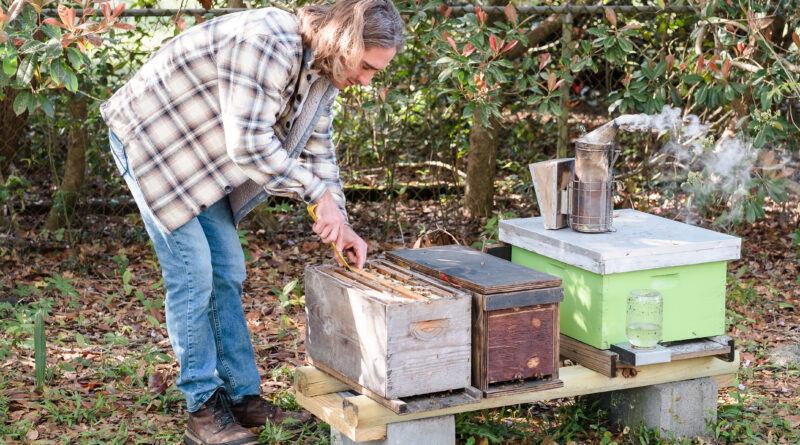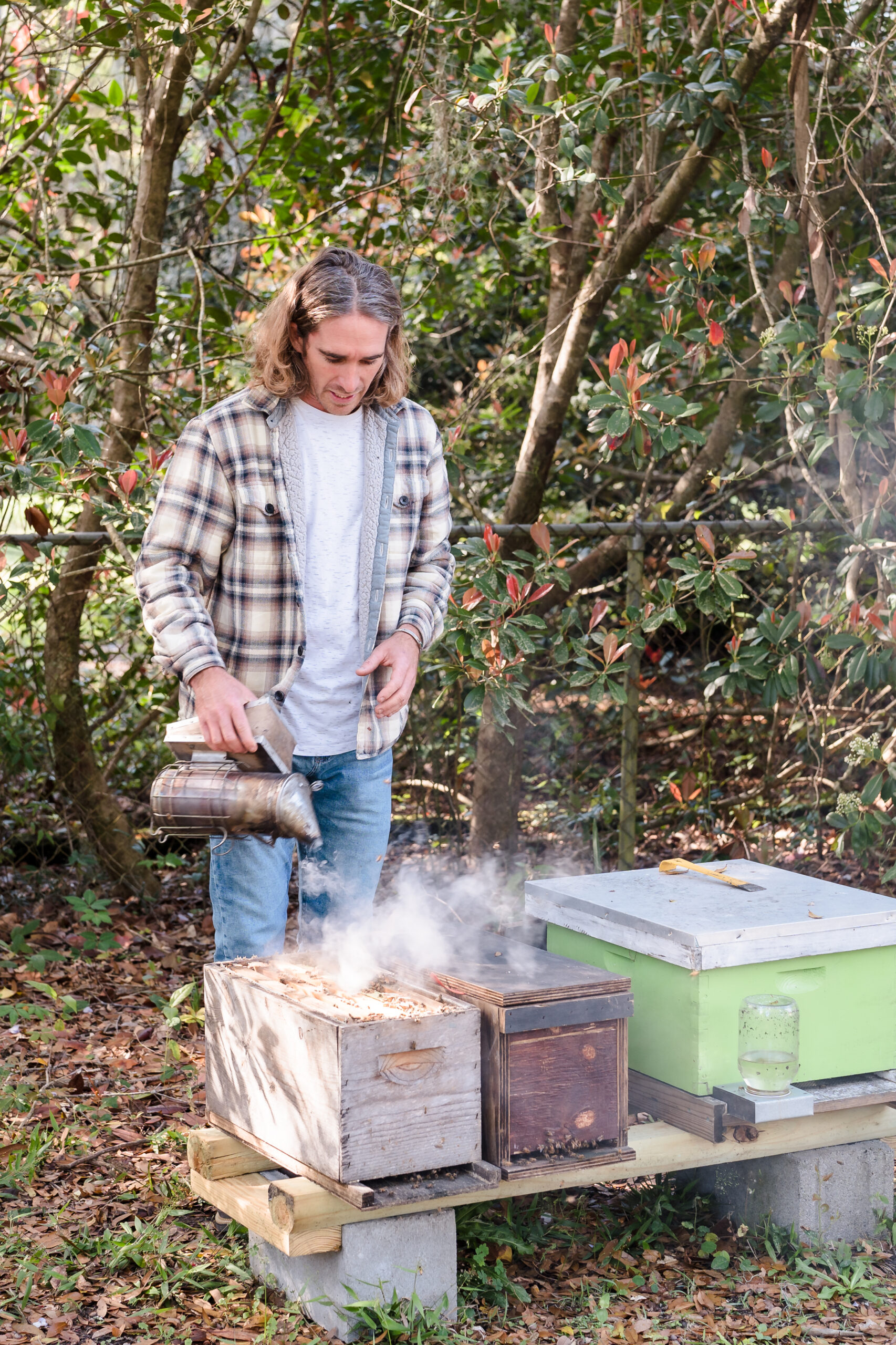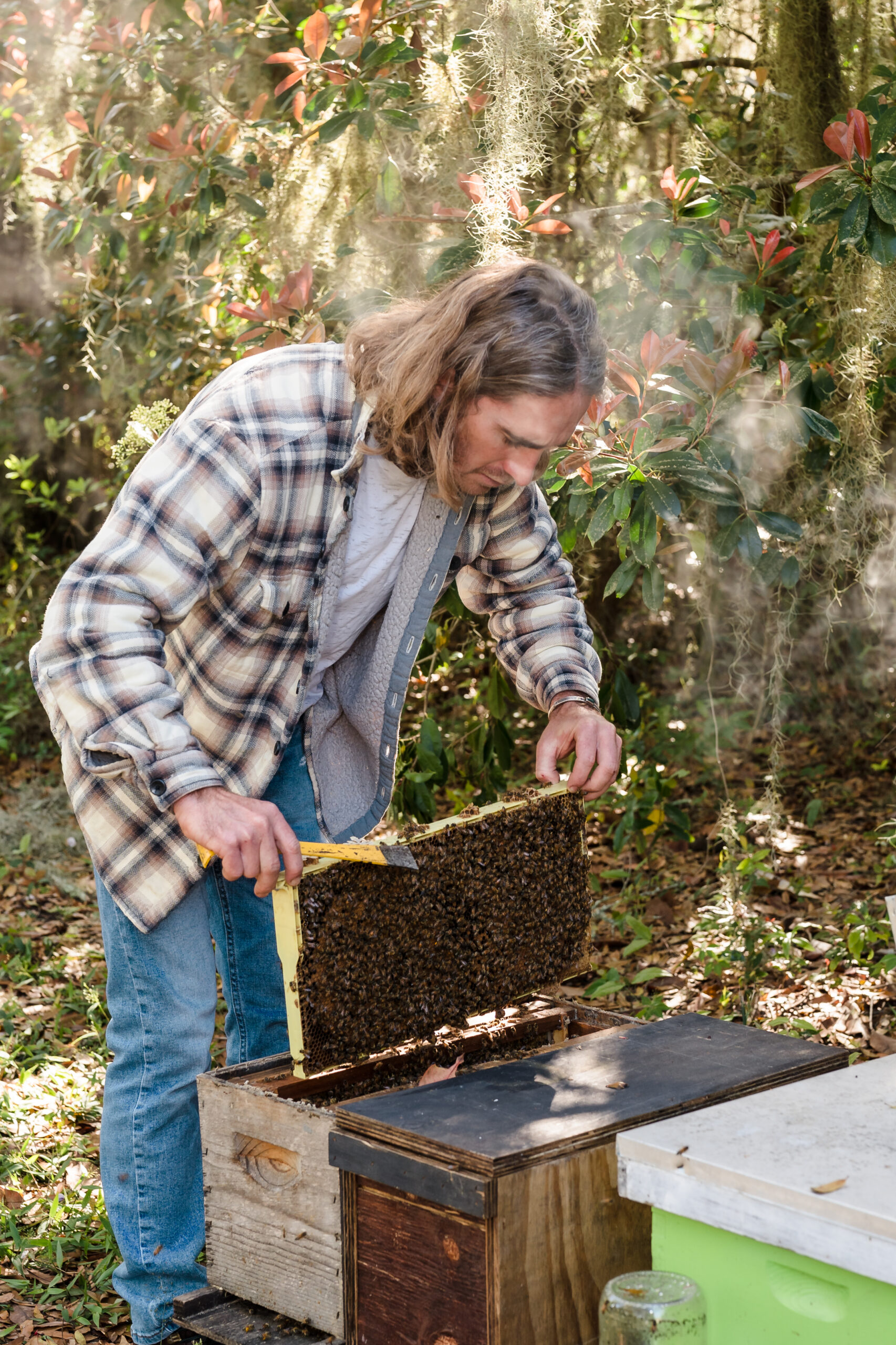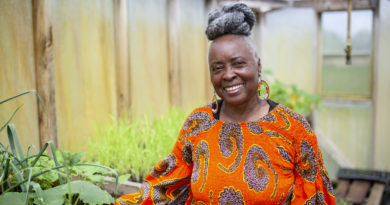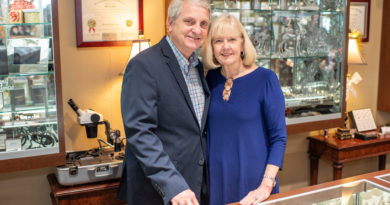Camp Arnold
“Beeing” the Change One Garden at a Time
story by TESS MALIJENOVSKY photos by SUSAN DELOACH
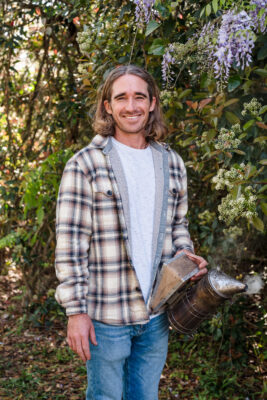 “I don’t think there’s anything cooler than planting a seed, watering it, nourishing it, watching it grow, and one day getting to eat from it,” says Camp Arnold, recalling how he went from being a massage therapist transplanted from Jacksonville, Florida, nearly a decade ago to becoming Beaufort’s “Honeybee Dundee,” rescuing wild swarms of honeybees barehanded from homes and businesses throughout the county.
“I don’t think there’s anything cooler than planting a seed, watering it, nourishing it, watching it grow, and one day getting to eat from it,” says Camp Arnold, recalling how he went from being a massage therapist transplanted from Jacksonville, Florida, nearly a decade ago to becoming Beaufort’s “Honeybee Dundee,” rescuing wild swarms of honeybees barehanded from homes and businesses throughout the county.
Now a local evangelist of sorts for the honeybee, the beekeeper is on a mission to dissolve the stigma that honeybees are to be feared and create a community of pollinator-friendly advocates in the process. He does this by helping others become beekeepers through his backyard beekeeping program, “Bee the Change.”
“I think when people see me handling bees without any protective gear and realize that I’m not getting stung — or that when I do, I’m hardly flinching — they get curious,” says Camp. “Without realizing it, they begin to rewrite the preconceptions they learned as a kid that bees are dangerous. And as their mind opens, their fears are often slowly replaced by fascination.”
Much like the bees, Camp’s calling as a beekeeper began with a draw to a garden. Or, in his case, a garden that began as an abandoned plot of dirt in Lobeco. It wasn’t until Camp moved to the Lowcountry that he truly discovered his love for country living — catching fish, foraging mushrooms and fruit from the wild, and harvesting vegetables, herbs, and flowers from his garden. He learned the patient art of living off the land from locals — shrimpers and fellow surfers he met in the water — who taught him, above all, what to look for.
“So often we don’t notice what surrounds us until someone points it out, gives it a name, and tells us its story,” says Camp, moving to crush a handful of cherry laurel leaves in his palm to reveal their cherry-almond fragrance. “My garden drew me to the bees, and now the bees draw me to everything that blooms around us.”
Back on that bare plot of country dirt, Camp took to permaculture, a gardening practice of cultivating a naturally resilient, self-sustaining ecosystem that generally doesn’t require pesticides or harmful fertilizers. He spent a few years building the soil, layering cardboard and compost, grass clippings, and manure, and burying fish carcasses like a sown prayer. And as he soon discovered, there is no miracle worker quite like the honeybee.
Three fourths of the world’s flowering plants and about 35% of the world’s food crops depend on pollinators, like honeybees, to reproduce. In fact, a single honeybee colony is estimated to pollinate 300 million flowers in a day. It wasn’t long before Camp observed this critical link and became interested in bringing honeybees to his garden.
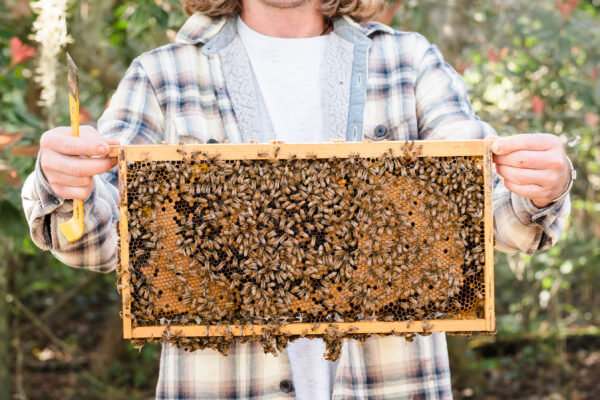
“One day, a Facebook post came to my attention about a swarm of honeybees outside a business in Port Royal that was up for grabs,” Camp recalls. Armed with a painter’s suit, duct-taped gloves, a bucket, a brush, and a hairnet over his face, he answered the call.
“I made every possible mistake in retrieving the bees,” he says. “Unfortunately, my mistakes led to their demise, and I felt terrible. But, those mistakes sparked my curiosity, and, ultimately, my future.”
After a 10-year career in massage therapy, Camp’s business ended abruptly during the pandemic. He didn’t know what to do next but said he was ready for a change. As fate would have it, Camp stumbled into the workshop of Greg Ferris of Ferris Apiaries, seeking answers and amends to his failed attempt to relocate bees to his garden.
Greg Ferris is an apiarist and woodwright of over 35 years in Yemassee who specializes in raising and shipping honeybees across the country for apitherapy, the medicinal use of honeybee venom in the treatment of several diseases. He offered Camp an opportunity to help around his shop in exchange for beekeeping knowledge.
“One of the first things I remember,” Camp says, “was making frames from scrap wood and shaking packages of bees into hives. I marveled at Greg’s Zen-like ability to handle bees without any protective gear. Meanwhile, it seemed every bee in his yard wanted blood from me. Many stings later, Greg asked if I wanted to do a bee removal with him, to which I reluctantly replied, ‘yes.’”
South Carolina is unique in that it’s one of only a handful of states with legislation that bans the extermination of honeybee colonies, even by pest control companies. Sadly, many homeowners still choose to spray bees and kill them. After all, removing and relocating tens of thousands of honeybees is not a job for the faint of heart.

On his first bee removal job, Camp remembers helping Greg slowly and painstakingly disassembling a colony of over 100,000 honeybees from the eave of a house. “The bees quickly put me in my place,” he says, certain they could smell his adrenaline and hesitation. Once the bees and their comb were taken out, the pair reassembled the eave as they’d found it, ensuring it was properly sealed to prevent future infestations. Their day was not yet over. The men transported the colony back to Greg’s apiary and, finally, transferred them into a hive.
“After a full day of countless stings, hot sun, torrential downpour, and honey-covered clothes, I was hooked,” says Camp.
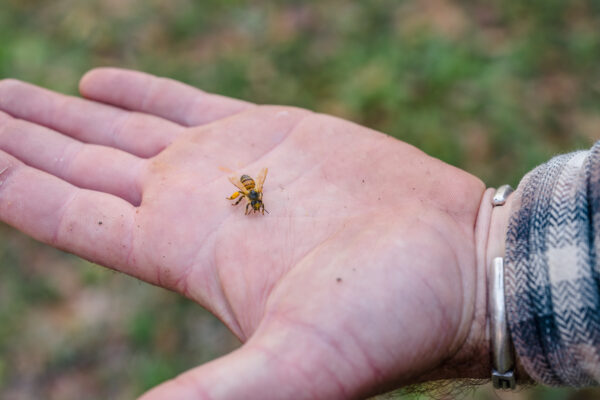 Camp left his massage therapy practice behind and joined Greg in a two-year mentorship, removing and relocating honeybee colonies that would otherwise be exterminated. No two jobs were the same. Camp quickly acquired the knowledge, experience, and skills to humanely remove honeybee colonies from every structure imaginable and put them back together. This was the genesis of his new business, Beaufort Bees.
Camp left his massage therapy practice behind and joined Greg in a two-year mentorship, removing and relocating honeybee colonies that would otherwise be exterminated. No two jobs were the same. Camp quickly acquired the knowledge, experience, and skills to humanely remove honeybee colonies from every structure imaginable and put them back together. This was the genesis of his new business, Beaufort Bees.
Armed with little more than a smoker, the young man can be seen climbing trees and walking around rooftops untethered as he slowly pulls honeycomb amidst a sea of bees with remarkable calmness. It’s a sight to see, and if you ever need his services, be sure to invite the neighbors to watch. Removing the colony is only half the work, however. Camp rehomes each bee colony with the salvaged comb, when possible, into hives on his apiary and throughout Beaufort. Much like his approach to gardening, he cares for his hives without using chemicals to treat mites or diseases.
“I prefer to let nature take its course and focus on breeding genetics that are resilient to disease and pests,” Camp says.
It’s no secret honeybee populations as well as many other pollinators have been in decline for years now, sending a ripple effect throughout our food supply chain and ecosystems. Last year, beekeepers in the U.S. lost an estimated 39% of their managed honeybee colonies, according to a survey by the nonprofit Bee Informed Partnership. That doesn’t include the estimated 150,000 to 300,000 beehives that were wiped out by Hurricane Ian in Florida, which big agriculture across the country was relying on.

Years of research have attributed the decline of the bees to a wide range of factors, including pests, diseases, pesticide exposure, pollutants, habitat loss, effects of climate variability, and monoculture intensification in food production.
“I’m just one beekeeper, but maybe if more people kept bees, collectively we could help rebound Beaufort County’s honeybee population,” Camp says. Last year, he launched his backyard beekeeping program, “Bee the Change,” to do just that.
“I know from experience that getting into beekeeping can be costly, intimidating, and a big commitment. The idea behind ‘Bee the Change’ is to help remove some of these barriers,” Camp says.
Participating homeowners and renters can host an active beehive in their backyards for a monthly fee. Each month throughout bee season, Camp visits the hive to manage the health of the colony and teach interested participants about beekeeping and the social order of honeybees. He provides beekeeping suits and tools for those who like to learn hands-on; and he guarantees raw, local honey for everyone who participates.
“The greater vision is to hopefully create a community in Beaufort that speaks up to their HOAs, Beaufort County Mosquito Control, and our elected officials on behalf of pollinators,” Camp says. “What hurts the bees also hurts the quality of our waters where we play and eat. Maybe we can inspire others to give up on the dandelions and stop using pesticides and herbicides. Maybe we can get more people to care about preserving the open spaces we have left, and together we can help the bees.”

